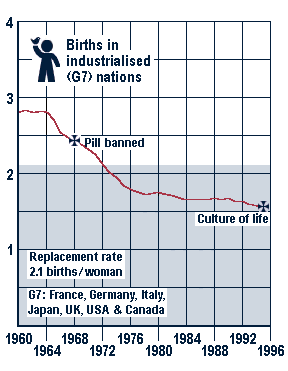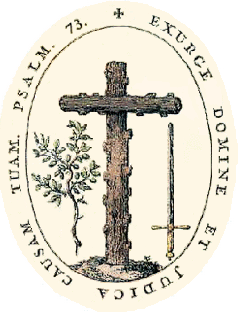 Life at all costs
Life at all costs
Traditionally the Catholic Church has been willing to accept the death of the body as mere collateral damage to the life of the soul, (so long as clerics did not have to shed the blood). However, the Vatican's new “culture of life” goes against this. It now calls many of the most effective kinds birth control “murder”, but keeps quiet about its earlier hangman, army and inquisitions. It is quiet, too, about the dozens of thousands of women who die each year where its rules are enforced.
♦ See also: Are Women Still Safe in Catholic Hospitals?
It's supposed to be all about preserving life but, given the Vatican's record, if that's really the case, it represents a remarkable conversion. In the Middle Ages and beyond, church courts passed death sentences, and then handed over the convicted to the state to carry them out. Another curiously anti-life practice has been Church support for numerous rightwing dictators, with their victims accepted as collateral damage in the fight against communism. [1]
Today another kind of carnage is taking place, and the Vatican is actively campaigning against measures that would help end it. This is the "preventable pandemic" of unsafe abortions, which in 2006 was estimated to take the lives of 68,000 women a year and to leave many more injured, sometimes permanently. [2] And sometimes the refusal of Catholic hospitals to induce labour early when the fetus has no chance of survival anyway puts the mother's life in jeopardy. Shocking stories about this practice in the US were revealed in 2016.
Like chimney sweeps who wore black to hide the soot, the papal executioner wore red
Today we hear no mention of the pope’s hangman, his army or his Inquisition. But Pope Francis' condemnation of the death penalty represents a U-turn. [3] For most of its history the Church exercised control through threats of death. And not just threats about what would happen to you after death: they also, on occasion, threatened to have you put to death.
 Church courts, the best-known of which are the Inquisition, [4] passed what they knew were death sentences and then handed the prisoners over to the state to be executed. (They were fastidious, of course, about not formally pronouncing or carrying out the death sentence themselves: holy men do not shed blood. [5])
Church courts, the best-known of which are the Inquisition, [4] passed what they knew were death sentences and then handed the prisoners over to the state to be executed. (They were fastidious, of course, about not formally pronouncing or carrying out the death sentence themselves: holy men do not shed blood. [5])
However, in the Papal States, the pope’s own kingdom in Italy, church and state were one, so that this formal separation did not hold. There the papal executioner worked so diligently that a bridge over the Tiber was described as adorned with more severed heads than there were melons in the market. [6] Tuscany, the Italian state next door to the pope’s domain, had abolished capital punishment in 1786. However, the pope only stopped the executions when he lost the power to continue them because he lost his kingdom. [7] And, in 1929, as soon as he regained a kingdom of his own, he enacted the death penalty for killing the pope. [8]
 For centuries the popes also waged war and even the end of the Papal State was marked by pontifically sanctioned bloodshed. In 1870 King Victor Emmanuel II (whom Pius IX had excommunicated ten years previously) made the Pope the face-saving offer of the peaceful entry into Rome of Italian troops to “protect” him. However, this Pius angrily rejected. Thus the papal forces, armed with an 1868 model of the Remington Rifle known as the Pontificio, were ordered to mount a hopeless defence. This resulted in dozens of unnecessary deaths.
For centuries the popes also waged war and even the end of the Papal State was marked by pontifically sanctioned bloodshed. In 1870 King Victor Emmanuel II (whom Pius IX had excommunicated ten years previously) made the Pope the face-saving offer of the peaceful entry into Rome of Italian troops to “protect” him. However, this Pius angrily rejected. Thus the papal forces, armed with an 1868 model of the Remington Rifle known as the Pontificio, were ordered to mount a hopeless defence. This resulted in dozens of unnecessary deaths.
Some nineteen papal soldiers and forty-nine Italian soldiers lost their lives in the associated battle. This “token” battle was itself brought to an end by the Papacy ordering its defenders to lay down their arms after making a show of resistance consistent with honour. [9]
It wasn’t until 2001, six years after the Catholic Church launched its “culture of life” programme that capital punishment was finally removed from the Vatican’s constitution. With this, the Church belatedly affirmed that it was opposed to the death penalty, as well. [10] Except, of course, for gays. In 2008 the Vatican refused to vote for a UN resolution calling for an end to discrimination against gays which was aimed in part at countries like Iran and Saudi Arabia, where homosexuality can be punished by death. [11]
Vatican support for murderous dictators
 Even after the end of the Papal States and the papal executioner, the Vatican supported a number of dictators who operated death squads. This was due to the frequent Vatican alliances with many rightwing dictators whose reigns of terror also kept people obedient to the Church. [12] By the 1960s, however, the usefulness of death threats had evaporated. The aged Franco was the last remaining Fascist dictator in Europe and it was clear that the Vatican would soon lose its staunch ally there. At that time
Even after the end of the Papal States and the papal executioner, the Vatican supported a number of dictators who operated death squads. This was due to the frequent Vatican alliances with many rightwing dictators whose reigns of terror also kept people obedient to the Church. [12] By the 1960s, however, the usefulness of death threats had evaporated. The aged Franco was the last remaining Fascist dictator in Europe and it was clear that the Vatican would soon lose its staunch ally there. At that time
Spain’s fertility was among the highest in Europe. The dramatic decline in fertility since then is associated with a shift from the pro-natalist Franco regime — which banned contraception and encouraged large families — to a democratic regime that has no explicit population policy. [13]
Still worse, from the Vatican's point of view, the new birth-control pill was giving women far more reproductive freedom and the birth rates in the industrialised nations began a steep decline, as these women were finally able to have the number of children they wanted.
How birth control became “intrinsically evil”
After the advent of the pill, Pope John XXIII appointed six lay people, referred to as the Pontifical Commission on Birth Control, to study the morality of birth control and population issues. The pope died that same year, and his successor, Pope Paul VI, expanded the Commission, adding a substantial number of clergy, including Cardinals, bishops, and priests, and appointed an executive committee of 15 bishops to construct the final report. The commission voted overwhelmingly to encourage the Church to rescind its ban on contraception and declared it not “intrinsically evil.” The final votes included “yeas” from 30 of 35 laypeople, 15 of 19 theologians, and 9 of 12 bishops (3 bishops abstained). [14]
However, any move to give women more freedom would not only weaken the Vatican's hold on them and curtail the growth of the Church, it also posed a direct challenge to the authority of the Church. This was because a previous pope had linked the contraception ban to the pope's infallibility. Therefore, at that point,
Cardinal Alfredo Ottaviani, the secretary of the Holy Office, told Paul that people had for years, on papal warrant, believed that using a contraceptive was a mortal sin, for which they would go to hell if they died unrepentant. On the other hand, those who followed “church teaching” were obliged to have many children unless they abstained from sex. How could Paul VI say that Pius XI, in his 1930 encyclical Casti Connubii, had misled the people in such a serious way? If he admitted it, what would happen to his own authority as moral arbiter in matters of heaven and hell? So Paul VI doubled down, adding another encyclical in 1968, Humanae vitae, to the unrenounceable eternal truths that pile up around a moral monarch. [15]
This document propounded a theory of Christian marriage which meant, in practice, that women were to be turned back into baby machines. That's because the only Church-approved method is, what a surprise, notoriously ineffective. It has been called “Vatican roulette”: “My mother used the rhythm method of birth control. Over the course of 18 years it only failed seven times.” [16]
Consistency conceals the reproductive aim of the “culture of life”
Something was needed to make the anti-pill campaign look like a high-minded philosophical principle, rather than an assault on women’s freedom. To accomplish this, consistency was essential.
Accordingly, in 1995 the papal letter Evangelium vitae announced the “culture of life”. This is a more general principle than the marriage doctrine, as it applied from conception to death. It defines fertilised eggs as people and insisted on their “right” to be born, whatever the situation of the mother. It also applies to the end of life, forbidding anyone the freedom to commit suicide or refuse many medical measures that would extend it. In 2004 Cardinal Ratzinger pointed out to American Catholics that the Culture of Life doesn't prohibit deciding to wage war or execute those defined as criminals. It only applies absolutely to "abortion or euthanasia" under which are included many forms of birth control and also suicide. [17]
Clamping down on end-of-life choices doesn’t seem to be the main aim of the new slogan, but it allows the Church to bid for an added bit of control. In the face of Church opposition an attempt to permit the dying to refuse treatment was voted down in the Spanish parliament in 2012. The pro-choice advocates had argued that “life is a right, not an obligation,” and introduced a bill that would have given patients the right to “understand at least the purpose and nature of each intervention and treatment, as well as the risks and consequences,” and to “refuse to consent to a treatment” if they so wished. [18]
Another bit of theoretical support for the “culture of life” was added in 2007 when a carefully selected group of Catholic theologians, the International Theological Commission, issued a document, “The Hope of Salvation for Infants Who Die without Being Baptized”. This strategic bit of theological speculation makes aborted foetuses into semi-martyrs who have a “baptism of blood”. This serves to apply additional theological pressure against abortion ― as does the rite of blessing foetuses announced by the US bishops the next year and approved by the Vatican in 2011. [19] Available in English and Spanish, this rite characterises the foetus as a child and could be seen as a kind of pre-baptism. It was also planned as a weapon. A US Bishop said, "It could be useful to those marching outside abortion clinics, to bless the mothers and children inside". [20]
Still a further doctrinal move is to redefine the whole concept of medical treatment in order to exclude any effective kind of family planning. The well-being of the patient or even her health is not considered by the Vatican to be the aim of medicine, only “restoring lost or compromised function”. Thus a leading Catholic bio-ethicist claims that “The Pill, when used for contraceptive purposes, does not constitute medicine in the proper sense of the term; it rather represents a decision on the part of the medical community to collude with a patient population in pursuing non-medical ends and morally problematic lifestyle agendas that threaten marriage, fidelity, and the chastity of young people.” [21]
Or is it really the “culture of obedience”?
As shown by polls from all over the world, few Catholic women wish to lead their lives according to Vatican reproductive policies. For instance, in the US 98.6 percent of Catholic women admitted to having used contraception. [22] However, elsewhere, many do not have this choice. The control imposed by the Vatican affects women more than men. That's because the hierarchy of obedience which goes from the pope to the parish priest doesn’t stop there: it continues on, from the head of the household down to his wife. Pius XI frankly stated that due to women’s different abilities there should be no co-education and even no “equality, in the training of the two sexes”. (On Christian Education, §68) Nothing should be allowed to interfere with the two great aims of “fecundity” and “authority”. (§31)
Women must be kept at home and bearing children for the Church. Ordaining them as priests would give them dangerous authority. On 29 May 2008 the Vatican issued a decree Regarding the crime of attempting sacred ordination of a woman. This is such a grave offence that it incurs automatic excommunication, on a par with heresy, schism, and laying violent hands on the Pope. In the summer of 2010 the Vatican backed this up by putting the ordination of women in the same class as paedophilia. (§13) At this time Benedict XVI also underlined his policy on women by appointing as number three in the Vatican hierarchy Cardinal Marc Ouellet shortly after he condemned abortion even in cases of rape. [23] And the Mexican Archbishop Fabio Martínez Castilla said in 2013 that “abortion is much worse than child rape by priests”. [24]
St. Paul is often cited in conservative Catholic circles, because he said that “the head of every man is Christ and the head of the woman is man”. (1 Corinthians 11:3) This was reiterated in florid theological prose by Benedict XVI less than a year before he was elected. For women to seek power, he claims, “leads to opposition between men and women, in which the identity and role of the one are emphasised to the disadvantage of the other, leading to [...] lethal effects in the structure of the family”. Et cetera, et cetera, et cetera.... [25]
Notes
1. “The chaplains and the ‘death flights’”, Concordat Watch. http://www.concordatwatch.eu/topic-48350.843
“The left gets a modus vivendi, the right a concordat”, Concordat Watch. http://www.concordatwatch.eu/topic-31871.843
2. David A Grimes et al, “Unsafe abortion: the preventable pandemic”, The Lancet, Volume 368, Issue 9550, Pages 1908 - 1919, 2006-11-25. http://www.thelancet.com/journals/lancet/article/PIIS0140-6736(06)69481-6/fulltext
3. “Pope calls for end to death penalty out of respect for human dignity”, CNA, 2014-10-27. http://www.catholicnewsagency.com/news/pope-calls-for-end-to-death-penalty-out-of-respect-for-human-dignity-79415/
4. The Inquisition, the special court to curb the spread of heresy, had three phases.
The Mediaeval Inquisition was begun to suppress the Cathars. In 1209 the pope declared a crusade against them and in 1232 decided to end this heresy once and for all by setting up special religious courts. The remote, mountain-top refuges of the Cathars can still be seen in Southern France today. Later the Inquisition spread to other parts of Europe to stamp out heresies ranging from witchcraft to Judaism.
The Spanish Inquisition established in 1478 by Queen Isabella and King Ferdinand, with Rome's approval, mostly targeted Jewish converts to Christianity. The Spanish Inquisition also spread to the New World. It was not abolished until 1834.
The Roman Inquisition was founded in 1542 as a Vatican agency to battle the Reformation, though it also dealt with other heresies, such as Galileo’s notion that the earth revolved around the sun. The Roman Inquisition still exists. Since 1965 it has been known as the Congregation for the Doctrine of the Faith, and was headed by Joseph Cardinal Ratzinger, now Pope Benedict XVI.
 The seal of the Roman Inquisition shows a cross made ominously by lopping off branches. Encircling this is the opening of Leo X's 1520 Bull of Excommunication against Luther: “Rise up, Lord, and judge your cause." Also mentioned is “Psalm 73” which contains lines such as “Thou hast destroyed all them that go a-whoring from thee".
The seal of the Roman Inquisition shows a cross made ominously by lopping off branches. Encircling this is the opening of Leo X's 1520 Bull of Excommunication against Luther: “Rise up, Lord, and judge your cause." Also mentioned is “Psalm 73” which contains lines such as “Thou hast destroyed all them that go a-whoring from thee".
Alessandra Stanley, “Vatican Is Investigating the Inquisition, in Secret”, New York Times, 31 October 1998.
Constitutional Rights Foundation, “The Inquisition: Looking into the Human Soul”. This is a mild introduction by a human-rights group intended for young people and has a bibliography that leads further.
5. Canon 18 of the Fourth Lateran Council, (“the most important of the Western Medieval general councils”) 1215 begins: “No cleric may pronounce a sentence of death, or execute such a sentence, or be present at its execution.” http://www.fordham.edu/halsall/source/lat4-select.html And Canon 3, on heresy, states “We condemn all heretics, whatever names they may go under. They have different faces indeed but their tails are tied together inasmuch as they are alike in their pride. Let those condemned be handed over to the secular authorities present, or to their bailiffs, for due punishment.” http://www.historyguide.org/intellect/3canon.html
[The archaic Spanish term was] relajamiento which means “”surrender of a heretic, who has been convicted by the Inquisition, to civil authorities in order to apply the death penalty.'” The Inquisition was not allowed by the church to kill anybody directly. Therefore, the sentence of death was carried out by civil authorities. A close parallel is the term “extraordinary rendition,'” where a similarly uneasy institution delivers suspects to other authorities so that they can be more energetically questioned or punished. “Surrender” = French “rendition” = legal English “rendition” = archaic Spanish “relajamiento.”
Carol N. Meredith, letter to the New York Times, 2008-02-10. http://query.nytimes.com/gst/fullpage.html?res=9E0DE0DD1531F933A25751C0A96E9C8B63&scp=53&sq=Inquisition&st=nyt
6. John L. Allen Jr., “He executed justice”, National Catholic Reporter, 2001.-09-14 http://www.natcath.com/NCR_Online/archives/091401/091401a.htm
7. The last execution in the Papal States on 9 July 1870, was carried out just a few days before the French emperor withdrew his troops and left the pope to deal on his own with both his disgruntled subjects and the Italian army. Ibid.
8. “Conciliation Treaty”, Lateran Pacts, 1929, Articles 8, 22, 23. http://www.shoaheducation.com/lateran.html
9. “Italian Unification. Cavour, Garibaldi and the Making of Italy”. http://www.age-of-the-sage.org/history/italian_unification.html
10. The revised Vatican Fundamental Law (equivalent to a constitution) that took effect on 22 February 2001 finally removed the death penalty:
Amnesty International, Death Penalty News, March 2001.
http://www.amnesty.org/en/library/info/ACT53/002/2001
Vatican City State - On 1 February the Vatican published a new constitution, signed into law by Pope John Paul II on 26 November 2000, which does not mention the death penalty. This is the first time the constitution has been amended since its inception in 1929 when the Vatican became a separate state within Italy.
The death penalty had been abolished in the Vatican City State's penal law by Pope Paul VI in 1969 but until now it had not been removed from the state's constitution.
11. Richard Owen, "Vatican stands up against further UN resolutions", The Times, 2008-12-03. http://www.timesonline.co.uk/tol/comment/faith/article5279114.ece
See also Philip Pullella, “”Vatican attacked for opposing gay decriminalization”, Reuters, 2008=12-02. http://www.reuters.com/article/worldNews/idUSTRE4B13QA20081202
A strongly worded editorial in Italy's mainstream La Stampa newspaper said the Vatican's reasoning was ‘grotesque’. Pointing out that homosexuality was still punishable by death in some Islamic countries, the editorial said what the Vatican really feared was a ‘chain reaction in favor of legally recognized homosexual unions in countries, like Italy, where there is currently no legislation’.
12. Vatican support for rightwing dictators is often expressed through treaties with them. Examples of concordats concluded with despots, large and small are those with Hitler, Mussolini, Franco, Duvalier, Trujillo, Dollfuss, Houphouët-Boigny, Aramburu and Onganía. See “The right gets a concordat, the left, a modus vivendi”. More detail can be found at the site of the Clero-Fascist Studies Project.
13. RAND, “Population Implosion? Low Fertility and Policy Responses in the European Union”, 2004. http://www.rand.org/pubs/research_briefs/RB9126/index1.html
14. “The Pontifical Commission and How Birth Control Became Known as Intrinsically Evil”, Reproductive Health Reality Check, 21 February 2012. http://www.rhrealitycheck.org/article/2012/02/21/pontifical-commission-on-birth-control
15. Garry Wills, “New Pope? I’ve Given Up Hope”, New York Times, 2013-02-12. http://www.nytimes.com/2013/02/13/opinion/new-pope-ive-given-up-hope.html
16. Reader comment #10 to “Choosing a Birth Control Method”, New York Times, 2010-08-20. http://well.blogs.nytimes.com/2010/08/20/choosing-a-birth-control-method/
And then there is the author of a book on what the Vatican now calls "natural family planning" who is described as “a wife of 15 years and a mother of nine”:
“The Sinner's Guide to Natural Family Planning”, Zenit, 2014-02-17 http://www.zenit.org/en/articles/the-sinner-s-guide-to-natural-family-planning
17. Cardinal Joseph Ratzinger, Prefect, Congregation for the Doctrine of the Faith, to Cardinal McCarrick, Archbishop of Washington, “Worthiness to Receive Holy Communion. General Principles”, June 2004. http://www.ewtn.com/library/CURIA/cdfworthycom.htm
18. “Spain’s main conservative and socialist parties join in rejecting euthanasia bill”, Life Site News, 2012-03-29. http://www.lifesitenews.com/news/spains-main-conservative-and-socialist-parties-join-in-rejecting-euthanasia/
19. The U.S. bishops’ moving new prayers for the unborn, Life Site News, 2012-05-14. http://www.lifesitenews.com/news/the-u.s.-bishops-moving-new-prayers-for-the-unborn
20. Bishops approve blessing service for children in the womb, Catholic News Service, 2008-11-11. http://www.catholicnews.com/data/stories/cns/0805732.htm
“Blessing of a Child in the Womb Ready for Use”, Zenit, 2012-05-09. http://www.zenit.org/article-34746?l=english
21. Rev. Tadeusz Pacholczyk, National Catholic Bioethics Center Director of Education, quoted in “Birth control use by women with common vein condition raises deadly blood clot risk to 1,700%”, Life Site News, 2011-08-10. http://www.lifesitenews.com/news/birth-control-use-by-women-with-common-vein-condition-raise-deadly-blood-cl
22. Contraceptive Methods Women Have Ever Used: United States, 1982–2010, National Health Statistics Reports, 2013-02-14, p. 8. http://www.cdc.gov/nchs/data/nhsr/nhsr062.pdf
For a constantly updated list of polls on what Catholic women really think, see http://www.catholicsforchoice.org/topics/catholicsandchoice/CatholicsandChoice.asp Also useful is a summary of recent opinion polls taken among US Catholics and non-Catholics of many different ethnic groups: Catholics for Choice, The Facts Tell the Story: Catholics and Choice, Washington, DC, 2011.
23. John Hooper, “Pope gives top job to abortion hardliner”, Guardian, 2010-06-30. http://www.guardian.co.uk/world/2010/jun/30/pope-abortion-cardinal-marc-ouellet
24. “Más grave abortar que violar a un niño, sacerdote de Chiapas”, Noticias Terra, 2013-04-29. http://noticias.terra.com.mx/mexico/estados/mas-grave-abortar-que-violar-a-un-nino-sacerdote-de-chiapas,62972805de85e310VgnVCM20000099cceb0aRCRD.html
25. Joseph Cardinal Ratzinger, Prefect of the Congregation of the Doctrine of the Faith, “Letter to the bishops of the Catholic Church on the collaboration of men and women in the Church and in the world”, 1.2 ff, 2004-05-31. 







